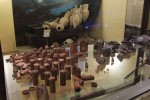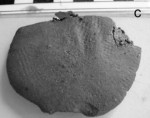 A shipwreck from 140 – 130 B.C. first discovered in 1974 off the coast of Tuscany near the Etruscan town of Populonia was found upon later excavation to contain a vast collection of trade goods from around the Mediterranean. Packed in the small ship (it’s at most 60 feet long and 10 feet wide) were Syrian glass bowls found still in stacks, pottery from Pergamon, wine amphorae from Rhodes, lamps from Ephesus, coins, lead vessels and other consumer goods. The most intriguing find, however, was a large cache of medical equipment. Tin cylinders called pyxides, 136 boxwood vials, a stone mortar, an iron probe and a bronze cupping vessel of a type used for bloodletting or for applying hot air to aching body parts, were discovered next to an iron lock that once belonged to a wooden box long since rotten away.
A shipwreck from 140 – 130 B.C. first discovered in 1974 off the coast of Tuscany near the Etruscan town of Populonia was found upon later excavation to contain a vast collection of trade goods from around the Mediterranean. Packed in the small ship (it’s at most 60 feet long and 10 feet wide) were Syrian glass bowls found still in stacks, pottery from Pergamon, wine amphorae from Rhodes, lamps from Ephesus, coins, lead vessels and other consumer goods. The most intriguing find, however, was a large cache of medical equipment. Tin cylinders called pyxides, 136 boxwood vials, a stone mortar, an iron probe and a bronze cupping vessel of a type used for bloodletting or for applying hot air to aching body parts, were discovered next to an iron lock that once belonged to a wooden box long since rotten away.
 Inside one tin pyxis was a rare archaeological treasure: five grey disc-shaped tablets stacked on top of each other like Mentos. Despite having spent 2120 or so years wrapped in dense marine flora on the seabed of the Baratti Gulf, the pyxis had remained water tight and the tablets were still intact. In 2010, scientists published the first DNA analysis on the tablets. They found evidence of a wide variety of plant matter — carrot, radish, parsley, celery, wild onion, cabbage, alfalfa, yarrow, hibiscus — in the pills, plants known from ancient sources to have been used for medicinal purposes. The still weren’t sure exactly what ailments the tablets would have been prescribed to cure, nor how they would have been taken by patients.
Inside one tin pyxis was a rare archaeological treasure: five grey disc-shaped tablets stacked on top of each other like Mentos. Despite having spent 2120 or so years wrapped in dense marine flora on the seabed of the Baratti Gulf, the pyxis had remained water tight and the tablets were still intact. In 2010, scientists published the first DNA analysis on the tablets. They found evidence of a wide variety of plant matter — carrot, radish, parsley, celery, wild onion, cabbage, alfalfa, yarrow, hibiscus — in the pills, plants known from ancient sources to have been used for medicinal purposes. The still weren’t sure exactly what ailments the tablets would have been prescribed to cure, nor how they would have been taken by patients.
Now a team of Italian researchers has thinks they’ve found the answer: they were probably used as an eyewash. Archaeologists from the Archaeological Superintendence of Tuscany, chemists from the University of Pisa and evolutionary biologists from the University of Florence examined the components of samples taken from a broken tablet with a scanning electron microscope, X-ray spectroscopy, infrared spectroscopy, X-ray powder diffraction and gas chromatography/mass spectrometry. They found that the main inorganic element was zinc. Zinc compounds like hydrozincite (zinc hydroxycarbonate) and smithsonite (zin carbonate) make up 75% of the tablet. Silicon and iron are second and third with 9% and 5% respectively.
 Organic components identified include starches that show evidence of having been cooked, animal lipids, vegetal lipids, beeswax, pine resin, 53 kinds of pollen and trace amounts of vegetal charcoal. Most of the pollen, 40%, was olive pollen. The runner-up with 13% was wheat. There were also some linen fibers, more of them on the outer part of the sample than the inner which could be the remnants of fabric used to wrap the pills. Any fabric that might have been cradling the tablets has decayed, but you can still see a texture on the outside of one that looks like the imprint of a textile.
Organic components identified include starches that show evidence of having been cooked, animal lipids, vegetal lipids, beeswax, pine resin, 53 kinds of pollen and trace amounts of vegetal charcoal. Most of the pollen, 40%, was olive pollen. The runner-up with 13% was wheat. There were also some linen fibers, more of them on the outer part of the sample than the inner which could be the remnants of fabric used to wrap the pills. Any fabric that might have been cradling the tablets has decayed, but you can still see a texture on the outside of one that looks like the imprint of a textile.
 The high zinc content suggests an ocular purpose for this remarkably complex medicine. Pliny the Elder and Greek physician Pedanius Dioscorides both mention that zinc oxide was collected from the walls of furnaces used during copper casting and then used in medication for the eyes and skin. The large, round shape of the tablets — they’re 3-4 centimeters in diameter and half a centimeter thick — also indicate they were used for eye treatment. The Latin word for eyewash is collyrium, derived from the Greek word κoλλυρα which means “small round loaves,” a pretty dead-on accurate description of the shipwreck tablets.
The high zinc content suggests an ocular purpose for this remarkably complex medicine. Pliny the Elder and Greek physician Pedanius Dioscorides both mention that zinc oxide was collected from the walls of furnaces used during copper casting and then used in medication for the eyes and skin. The large, round shape of the tablets — they’re 3-4 centimeters in diameter and half a centimeter thick — also indicate they were used for eye treatment. The Latin word for eyewash is collyrium, derived from the Greek word κoλλυρα which means “small round loaves,” a pretty dead-on accurate description of the shipwreck tablets.
As for how these pastilles would have been applied to the eye, that’s where the beeswax comes in. The pills were probably melted and the resulting unguent applied to the ailing eye.
You find the most interesting stuff! :boogie:
It would be interesting if someone in the medical profession would take a look at these and determine whether they actually provided any real treatment or analgesic effect, or if it was pretty much a placebo.
Zinc oxide is used for dermatological purposes today. You’re not supposed to get it in your eyes, though. Maybe it was used for around the eye, like more of a kill-your-crow’s-feet thing than a heal-your-conjunctivitis thing?
I wonder if this might be the “eyesalve” mentioned in Revelation 3:18 – “…and anoint thine eyes with eyesalve, that thou mayest see”.
Wikipedia carries a sentence that reads “The reference to eye medication is again often thought to reflect the historical situation of Laodicea. According to Strabo (12.8.20) there was a medical school in the city, where a famous ophthalmologist practiced. The city also lies within the boundaries of ancient Phrygia, from where an ingredient of eye-lotions, the so-called “Phrygian powder”, was supposed to have originated.
Some of the stuff on that ill-fated ship originated in Asia Minor, I suppose it’s possible it contained some of the highly-prized eye salve. Ya think?
Waidmann
It’s certainly possible. With all those ingredients and the complexity of preparation, I doubt it was a cheap concoction. Also, they must have been valuable to the doctor for him to place the pills in such a remarkably well-made pyxis.
Ok, my first idea was instant soup or stock cube: ‘variety of plant matter — carrot, radish, parsley, celery, wild onion, cabbage, alfalfa, yarrow, hibiscus … starches that show evidence of having been cooked, animal lipids’, but indeed, there is usually no zinc. Zinc oxyde, however, is still used today.
From a pot that I just picked in my bathroom: ‘ingredients: petrolatum, zinc oxyde, lanolin, talc, aqua, … ‘ (no parsley whatsoever). Like probably parsley, I think zinc oxyde is considered to be antiseptic. And as I could not see that: Is there any hint on what exactly brought Ophtalmology onto the table ? Also, what material is the pyxis ?
Zinc is mentioned in ancient sources as having ophthalmological uses, thus the preponderance of zinc in the preparation suggests it was intended to cure illness of the eye. As Cordate says, the pyxis is tin.
The amazing pyxis is tin! Two mellenia old and still water-tight! Maybe they ought to get its maker creating containers for nuclear waste.
That was one helluva soldering job, amirite? It defies belief.
I have a question for this website…
You were half right and half wrong.
What you have there is something rare…something I need very badly…
It is a type of very rare eye salve, however to PROVE I AM RIGHT…
It was not melted…
It was ground up in the mortar and mixed with blessed water…
What you have is known as Phyrigian Powder…however like I said you can’t melt it…
You have to crush it up into dust and mix it with holy water and it will cure you.
The mix is poured on the eyes.
This Phyrigian Powder is something I need because I am spiritually affected by a curse. If anyone can help me or introduce me to whoever holds these, I will gladly show you how to prepare the eye salve.
Please email if you can help.
He is with us even until the end of the age…
You are correct.
It is Phrygian Powder.
Do you know how to get a hold of the website?
I have been looking for this panacea for years.
Interested in discovering the modern equivalent in ingredients if you have any details on this it would be greatly appreciated.
thanks, take care
John